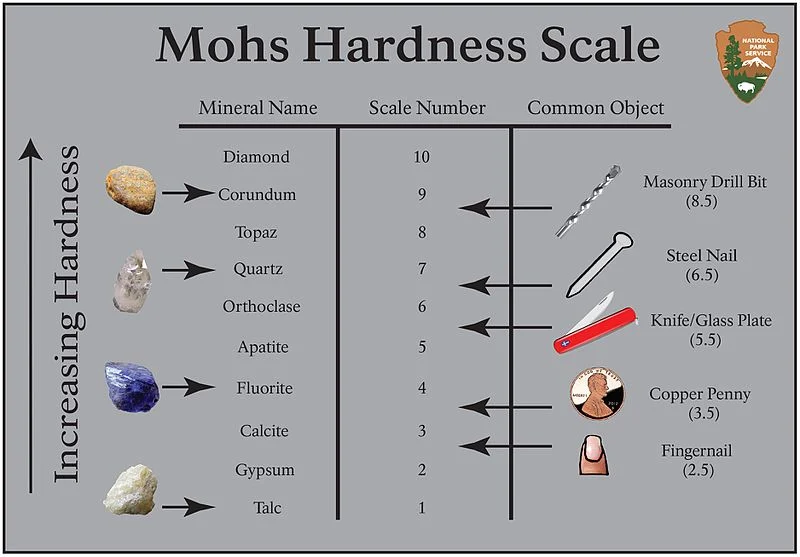The Mohs Scale of Hardness is a qualitative scale that ranks minerals based on their ability to resist scratching. Developed by German mineralogist Friedrich Mohs in 1812, the scale is widely used in geology, gemology, and material science to compare the hardness of different minerals and gemstones. It ranges from 1 (softest) to 10 (hardest), with each mineral capable of scratching those ranked below it while being scratched by those ranked above it.
Mohs Scale of Hardness – Ranking of Minerals
Mohs Hardness Mineral Common Comparison
1 Talc Very soft; can be scratched by a fingernail; found in talcum powder.
2 Gypsum Soft; can be scratched by a fingernail; used in plaster and drywall.
3 Calcite Can be scratched by a copper coin; found in limestone and chalk.
4 Fluorite Can be scratched by a knife blade; used in fluorine production.
5 Apatite Can be scratched by a steel nail; found in teeth and bones.
6 Orthoclase Feldspar Harder than glass; a common mineral in granite.
7 Quartz Can scratch glass and steel; commonly found in sand and gemstones like amethyst and citrine.
8 Topaz A durable gemstone; harder than quartz and feldspar.
9 Corundum Includes sapphires and rubies; extremely hard, only scratched by diamond.
10 Diamond The hardest naturally occurring substance; used in cutting tools and jewelry.
Understanding the Mohs Scale
The Mohs scale is ordinal, meaning the difference in hardness between minerals is not proportional. For example, diamond (10) is about four times harder than corundum (9), even though the scale suggests a difference of only one unit.
Some synthetic materials and alloys can exceed the hardness of natural minerals. For example, tungsten carbide and cubic boron nitride have hardness levels approaching that of diamond.
While hardness measures scratch resistance, it does not indicate a mineral’s toughness or resistance to breaking. Diamond, while the hardest mineral, is brittle and can be shattered by a sharp blow.
Mohs Scale and Gemology
In gemology, the Mohs scale helps determine the durability of gemstones for everyday wear. Harder stones (e.g., diamond, sapphire, ruby) are ideal for engagement rings and jewelry exposed to frequent wear, while softer stones (e.g., opal, pearl, turquoise) require extra care to avoid scratches.

